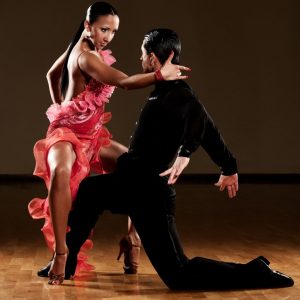Don’t get waylaid by these five common dance injuries.
No matter how careful you are, sporadic overuse injuries are an occupational hazard of professional dance. “Dance looks great because it’s an unusual movement—it’s not natural to the body, so your body may react negatively to it over time,” says Johann Howard, physical therapist at the Harkness Center for Dance Injuries at New York University Langone Medical Center. Fortunately, you can minimize the occurrence of chronic problems if you recognize the warning signs and are prepared to let your body heal effectively.
 ~FHL Tendonitis
~FHL Tendonitis
Also called “dancer’s tendonitis,” flexor hallucis longus tendonitis is an inflammation or tear in the tendon that travels under your calf muscle, inside the ankle bone and along the bottom of the foot to help point the big toe. “This is one of the few tendons that passes through a bit of a tunnel, so when it’s swollen and inflamed, it can get stuck,” says Nancy Kadel, MD, orthopedic surgeon and chair of the Dance/USA Task Force on Dancer Health. “Ballet dancers with FHL tendonitis will generally feel pain when going from demi-pointe to full pointe, since that bends the big toe down.” FHL tendonitis can also cause a “trigger toe,” meaning the big toe clicks or gets caught, sometimes requiring straightening out with your hand.
Risk factors: FHL tendonitis comes from repetitive pushing off with your foot during jumps or while going from plié to relevé. “The key is to have balanced strength and flexibility all around your ankle,” says Kadel, who adds that it can be helpful to be evaluated by a physical therapist to be sure you’re not overstretching or compressing the tendon while dancing.
Recovery: It usually takes four to six weeks (or longer for a tear) to recover, as long as you don’t ignore the pain and seek medical treatment. “If your pain is above a 3 out of 10, don’t dance,” Howard says. “Instead, ask your physical therapist for safe strengthening exercises.” Kadel has her patients gradually return to class, perhaps leaving out pointework, grand pliés or jumps until pain has completely subsided. She may also recommend ice massages to reduce inflammation, or sleeping in a night splint to keep the foot in a neutral position.
Prevent relapse: Dancers should be able to avoid relapse as long as they maintain proper foot alignment and continue strengthening and stretching the area throughout their career.
~Stress Fractures
In dancers, stress fractures—tiny cracks in the bones due to repetitive overloading—are often found in the metatarsals (the long bones of the foot). “Dancers will describe a toothache-like pain on the top of the foot that gets worse when jumping or turning,” Kadel says. “In the beginning, you may not see any swelling or bruising, but it will gradually become more painful.”
Risk factors: Kadel suggests thinking of the long, thin metatarsal bones like wire hangers. “It won’t break the first time you bend it, but after bending it 50 times, it may,” she says. “Every time you load the bone beyond its limit, it has a reaction and then heals itself, but with overuse, you’re not giving that bone enough time to heal, so it cracks.” Stress fractures become more likely during periods of increased activity—like in preparation for a big performance or during a summer intensive—or for dancers with weaker bones due to poor nutrition.
Recovery: Katie Lemmon, certified athletic trainer at Athletico Physical Therapy in Chicago, says this injury may land you in a boot for several weeks, especially if it hurts to walk. “Dancers with stress fractures shouldn’t be doing weight-bearing activity, but I’ll often give them other strengthening exercises like Pilates, so it’s only a modified rest,” Lemmon says. You’ll be able to monitor your recovery by how much pain you feel, but you should still be under the care of a medical professional to determine when it’s safe to return to different stages of dancing. It may take three weeks or more before you’re able to try jumping on two feet, and longer before you’re able to safely perform grand allégro.
Prevent relapse: “Since stress fractures are often caused by a muscle imbalance, use the recovery time to look for the underlying cause, which will prevent it from happening again,” says Lemmon. As long as you listen to your body, bone heals without scar tissue, so relapse is unlikely.
~Lower Back Pain
 Dancers are at especially high risk for straining their lower back muscles. This pain feels like a dull ache or discomfort on one or both sides of your spine (not directly on it), and may feel especially painful in arabesque.
Dancers are at especially high risk for straining their lower back muscles. This pain feels like a dull ache or discomfort on one or both sides of your spine (not directly on it), and may feel especially painful in arabesque.
Risk factors: “Lower back pain often comes when dancers are trying something new, whether it’s new choreography or a different style of dance, and when dancers have weakness in their core muscles,” Kadel says. “For example, dancers’ back muscles may get overwhelmed by all the penchées on one leg while rehearsing La Bayadère.” Too much repetition on muscles that aren’t quite strong enough may lead to the muscle fibers being stretched, torn or inflamed.
Recovery: Strains in the lower back can take quite some time to heal—according to Howard, up to two or three months. Depending on the injury, you may be able to take modified class throughout your recovery or need to suspend all dancing to allow for proper healing. When appropriate, a physical therapist may help you stretch the affected muscles and offer back and abdominal strengthening exercises, like planks and movements that target the lower abs.
Prevent relapse: “With lower back pain, you can almost guarantee it will come back,” Howard says. “So it’s important to self-manage and come back to physical therapy when you anticipate something will aggravate it or if you start feeling pain.”
~Ankle Sprains
“A sprained ankle means you’ve partially torn one of the ligaments between your ankle bones,” Kadel says. “They’re often caused by fatigue, and are by far the most common injury I see.” While ankle sprains usually happen suddenly, the precursors are often dwelling for some time.
Risk factors: The biggest risk factor for spraining an ankle is having done it before. Others include higher-arched feet, very flexible ankles and, like most chronic injuries, muscle imbalances. Kadel encourages dancers to spend just as much time strengthening the outside muscles as the inside muscles of the ankle—those you use for winging and sickling.
Recovery: Sprains are generally graded on three levels, with the least severe healing in about three weeks and the most severe taking up to 12. For bad sprains, Howard says dancing at all may be off limits, and you may have to wear a boot for a few weeks. “Some ankle sprains are so painful that there’s no way you could dance even if you wanted to,” he says. “In physical therapy, we’ll slowly start to introduce perturbation exercises, which means balancing on a pillow or wobble board to build ankle strength.”
Prevent relapse: Your physical therapist may recommend core workouts to build strength to help prevent future sprains. “Even after you heal, it’s important to keep doing those physical therapy exercises like a religion,” Howard says. Once you’ve had one sprain, you’ll always be at a higher risk to get another.
~Shin Splints
Shin splints, or medial tibial stress syndrome, describes a generalized pain on the inner edge of the shin bone (tibia). Shin splints may feel worse with certain movements, like jumping or pointing your foot.
Risk factors: Shin splints often occur during an increase in activity, which overworks the muscles, tendons and bone tissue. Hard floors can exacerbate the pain. Shin splints can be more likely in dancers with very high arches or flat feet. “We also see shin splints caused by dancers gripping their toes too hard on the floor,” Lemmon says. Teenagers are particularly at risk: When dancers grow quickly, their lower leg bones often grow faster than their muscles, which can lead to discomfort.
Recovery: With proper care, rest and ice, the pain of shin splints should subside in two to four weeks. “In physical therapy, we’ll work on core exercises, calf stretches and hip-strengthening exercises so dancers aren’t using their toes to keep their balance,” says Lemmon. “Usually we’ll start with less-weight-bearing exercises and progress to more-weight-bearing exercises over time.” Dancers can take a modified class, but as with any chronic injury, any movement that causes pain is preventing your body from healing and should be avoided.
Prevent relapse: Continuing physical therapy exercises and stretches long after you’ve healed can prevent relapse.
North Shore Dance Society, Ballroom, Latin, Social & Competitive Dancing
Ballroom dance Evanston social competitive Latin Salsa WCS Argentine Tango
Article from dancemagazine.